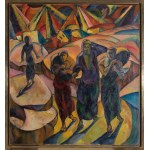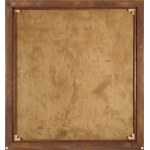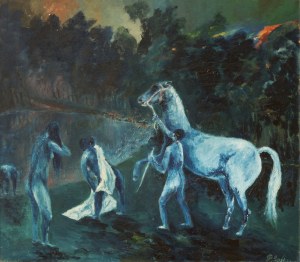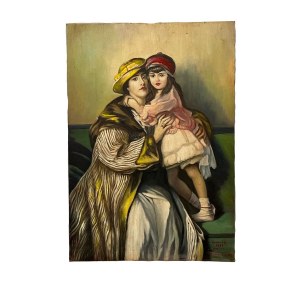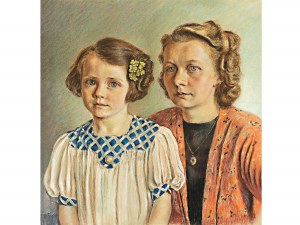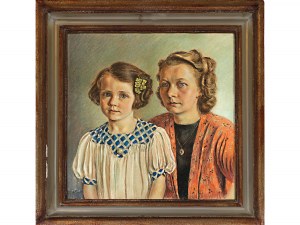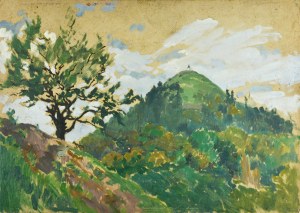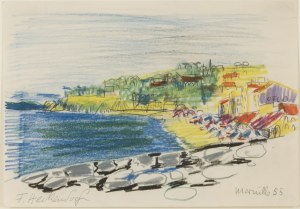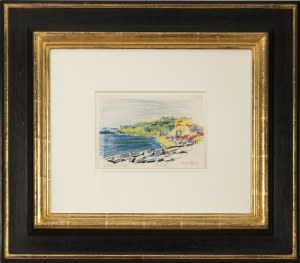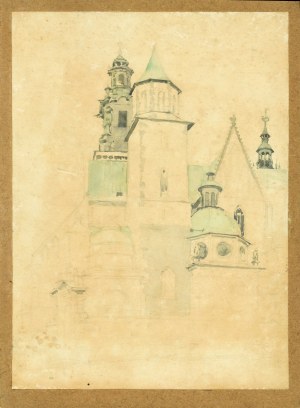WILLI KOHL*
(Aachen 1888 - 1971 Aachen)
Lot and his Daughters, 1919
oil/canvas, 120 x 112 cm
signed W. Kohl and dated 19
depicted in Expressiver Realismus in Deutschland, Vienna 2017, S. 21
Provenance: private collection Germany, Gallery Elisengarten Aachen (Germany), Fine Arts Widder
ESTIMATE °€ 15.000 - 25.000
START € 13.000
German painter of the 20th century. Attended the Aachen School of Arts and Crafts and studied at the Academy in Munich and Stuttgart. From 1926 in Berlin, worked as a graphic artist mainly as studio manager of the Berliner Tagesblatt. Member of the Verein der Berlinder Künste and the Munich Secession. 1928 Returned to Aachen, head of the class for commercial art at the Werkkunstschule. Together with the dialect poet and newspaper scholar Will Hermanns, the sculptor Alfred Pieper, the decorator Hein Lentzen and the engineer Joseph Lausberg, founded the Aachen Marionette Plays. Created landscapes, still lifes and cityscapes, but also biblical scenes such as the scene from the Old Testament. Taken from the Book of Genesis, Lot and his daughters flee from Sodom and Gomorrah.
Aachen-born student of the local School of Applied Arts and student of the art academies in Munich and Stuttgart Willi Kohl deals here with one of the most famous episodes from the Book of Genesis of the Old Testament. The fall of Sodom and Gomorrah. Immediately before this catastrophe, Lot was commanded by two messengers of God to leave the city quickly with his family, "without looking behind him." But because Lot hesitated for the time being, the messengers of God brought him to safety along with his wife and two daughters. They were told to retreat to the mountains, but Lot did not want to do so, so he asked his companions if they could seek refuge in the city of Zoar instead, which Lot was now allowed to do. At sunrise, the Lord rained down sulfur and fire from heaven on Sodom and Gomorrah. But because Lot's wife turned around against the instruction of the angels, she froze to a pillar of salt, with which only Lot and his daughters should remain alive in the course of this rescue action. Kohl compresses the decisive moments of this parable about the depravity of mankind, the wrath of God and his protective hand over the God-fearing in a simultaneous depiction. In the somber foreground Lot flees with his two daughters from the city, which is already sinking in fire and brimstone. Despite stylization in the details and the drawing of the figures, the painter describes the togetherness and juxtaposition of the figures. Lot's daughters have shouldered their most necessary belongings and flank their father. The father is leaning with his right hand on a walking stick, while he grasps his forehead with his left hand. With it he expresses probably his incomprehension for his wife, who separated from the group, in order to throw a view of the burning city. In the middle ground on the left Lot's wife, who did not know how to restrain her curiosity and negated the divine instruction, has frozen to a pillar of salt. If one takes into account the time when this painting was created, the year 1919 as the first year of peace after the end of the First World War, which plunged the old Europe into ruins and, because of the necessary reconstruction work, did not allow a glorified look back to the old times, then perhaps a second level of meaning resonates here. In this composition, Kohl works with prismatic and rhythmic forms and relies on motivic repetition as well as on a cubist-based abstraction. Kohl positions the main group in the foreground, which is moving in shadowy unison to safety from the inferno over the godless city, in front of a landscape brightly illuminated in the firelight, whose degree of abstraction seems to be heightened even further in the direction of the background. One could almost speak of a rupture that emerges here in the choice of means of abstraction in the foreground and background design. The spatial stage of the foreground is characterized by originality in form and content. Kohl organizes it from stylized rock formations that owe their plastic effect to color-shaded edges and vertical surfaces. With variegated faceted cones of color fanning out broadly over the staccato roofscape, Kohl hints at the burning down of the city in the background. What at first seems like a chaotic architectural etude nevertheless follows an orderly structure. Kohl refers stylistically to the Russian pioneer of abstract painting, to the Russian painter Wassily Kandinsky, whose theory of abstraction defined the field of reference between reality and abstraction: "Abstract art creates a new world alongside the "real" world, which from the outside has nothing to do with "reality". Inside it follows general laws of "the cosmic world". Thus, next to "the world of nature" appears the new "world of art" - a very real, concrete world. That is why I prefer to call the so-called "abstract art" the concrete art". In addition to Kandinsky, there are echoes in Kohl's paintings of the colorful abstract compositions of Adolf Hölzel, who was also one of the early pioneers of Classical Modernist painting. Hölzel and his constant desire to experimentally expand artistic means and sensitively reflect on the laws of pictorial creation obviously also encouraged Kohl to quickly switch between the different modes of abstraction and to apply them even within a single painting. Kohl, who moved to Berlin in 1926, subsequently benefited from this ability when, as studio manager of the Berliner Tagblatt, he turned increasingly to artistic commercial art. From 1948, as director of the Werkkunstschule in his hometown of Aachen, he was to make it his subject of instruction as well.
PLEASE NOTE:
The purchase price consists of the highest bid plus the buyer's premium, sales tax and, if applicable, the fee of artists resale rights. In the case of normal taxation (marked ° in the catalog), a premium of 24% is added to the highest bid. The mandatory sales tax of 13% is added to the sum of the highest bid and the buyer's premium. The buyer's premium amounts to 28% in case of differential taxation. The sales tax is included in the differential taxation.
Zuletzt angesehen
Bitte melden Sie sich an, um die Liste der Lose zu sehen
Favoriten
Bitte melden Sie sich an, um die Liste der Lose zu sehen




